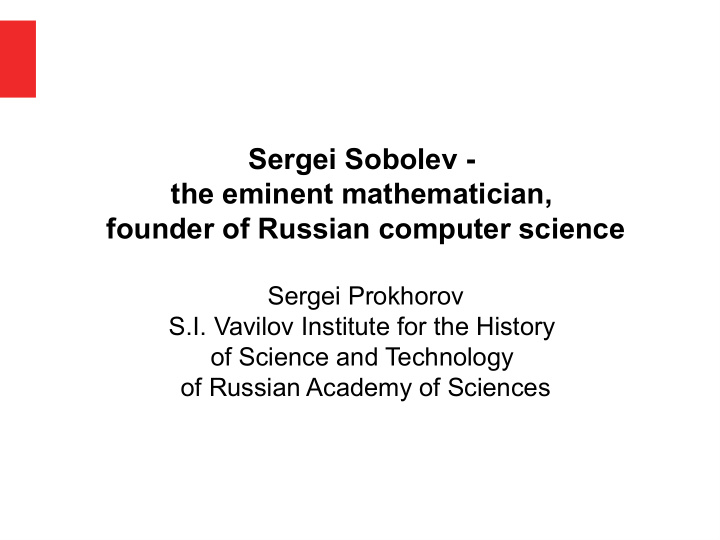



Sergei Sobolev - the eminent mathematician, founder of Russian computer science Sergei Prokhorov S.I. Vavilov Institute for the History of Science and Technology of Russian Academy of Sciences
Sergei L'vovich Sobolev is the eminent mathematician whose work had a substantial influence on the development of twentieth century mathematics. Sobolev made fundamental contributions to the theory of partial differential equations, functional analysis, function theory, mathematical physics, and computational mathematics. His outstanding mathematical results were highly appreciated by his colleagues. At the age of 25, he was elected a corresponding member of the USSR Academy of Sciences, and at 31 he was already an academician.
Less well known is the fact that Sergei Sobolev was the founder of Computer Science in the USSR/Russia. He took active participation in the development of the architecture of the first Soviet computer M1 and in developing the first computer program in the USSR for "atomic project". Really in fact he was the first professional programmers in Russia. Thanks to him, theoretical and practical programming became scientific disciplines.
In 1943, Sobolev began working at LIPAN (LIPAN is the Russian abbreviation for the Laboratory for Measuring Instruments of Academy of Sciences). The laboratory worked intensely to build a nuclear shield for the USSR. Sobolev faced applied mathematical problems the solution of which required tremendous effort because it was necessary to calculate, optimize and predict extremely complicated processes never studied before. He worked with physicists and was involved with a lot of numerical computation at a time when computer was not yet available as a calculating tool.
The number of applications requiring accurate calculations has steadily increased. The price of the error was very high. This concerned both technical issues and political responsibility. In 1948, at the Energy Institute of the Academy of Sciences, under the leadership of the corresponding member of the Academy of Sciences Issak Brook, work began on the design of a universal electronic computer. Sobolev began to work actively with the team of Isaac Brook in early 1951, as soon as the M1 computing unit has been assembled.
Sobolev's influence on the process of creating the M1 was very significant. In particular, he actively supported the implementation of the two-address instruction. The creators of the first computers believed that a three-address command system must be implemented. But mathematicians drew attention to the fact that in many cases the result of the operation is one of the operands for the next operation. It was a brilliant idea. Application of the two-address instruction instead of three-address allowed to significantly expand the scope of addressable memory, and the range of problems solved on the M1, in particular, it allowed programming the calculations on the matrices .
From October to December of 1951 M1 was used in test mode. At this time, Sobolev prepared and programmed a number of test tasks that have been successfully solved on the computer. The successful solution of test tasks convinced Sobolev and his team that the computer was working stably, that the computer could be used to perform complex scientific calculations. December 15, 1951 M1 was put into operation. In early 1952, Sobolev spent on M1 calculations for handling matrices of large dimension for problems related to the gaseous diffusion enrichment of uranium. In the USSR, it was the first application of electronic computer to perform complex scientific calculations.
It will not be a strong exaggeration to say that Sobolev was the first professional programmer in the USSR. His professionalism was manifested primarily in the fact that he well understood the architecture of the computer. He was well aware of the computing capabilities of M1, its strengths and weaknesses. He wrote a large number of tests for the machine to check its functionality. In the program, prepared by himself always provides for the possibility of failure of the machine during the computation and resuming accounts using intermediate results. It was a very professional approach and an important example for other users in a situation where there was no experience with computers, when there was not even such conception as a programming technique.
In the formation of computer science in the USSR participated many specialists. But perhaps Sobolev best of all other understood the importance and future prospects associated with the emergence of computers. He was the leader one of major scientific and engineering area, who had the experience of computer programming. Based on this experience, he was be able to realistically assess the prospects for the use of computers. And not only appreciate, but also to take practical action to support and develop new directions. Sergei Sobolev is one of the greatest mathematicians of the XX century. He can also rightly be called the pioneer of Russian and Soviet computer science.
THANK YOU !!
Recommend
More recommend